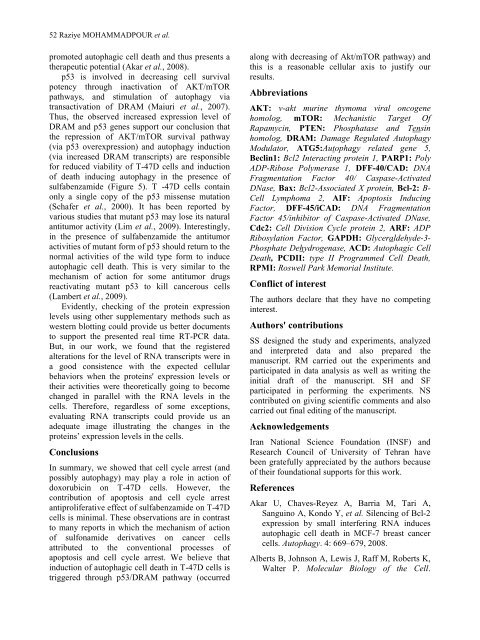10 1 Full Volume (PDF)(jcmb.halic.edu.tr) - Journal of Cell and ...
10 1 Full Volume (PDF)(jcmb.halic.edu.tr) - Journal of Cell and ...
10 1 Full Volume (PDF)(jcmb.halic.edu.tr) - Journal of Cell and ...
Create successful ePaper yourself
Turn your PDF publications into a flip-book with our unique Google optimized e-Paper software.
52 Raziye MOHAMMADPOUR et al.<br />
promoted autophagic cell death <strong>and</strong> thus presents a<br />
therapeutic potential (Akar et al., 2008).<br />
p53 is involved in decreasing cell survival<br />
potency through inactivation <strong>of</strong> AKT/mTOR<br />
pathways, <strong>and</strong> stimulation <strong>of</strong> autophagy via<br />
<strong>tr</strong>ansactivation <strong>of</strong> DRAM (Maiuri et al., 2007).<br />
Thus, the observed increased expression level <strong>of</strong><br />
DRAM <strong>and</strong> p53 genes support our conclusion that<br />
the repression <strong>of</strong> AKT/mTOR survival pathway<br />
(via p53 overexpression) <strong>and</strong> autophagy induction<br />
(via increased DRAM <strong>tr</strong>anscripts) are responsible<br />
for r<s<strong>tr</strong>ong>edu</s<strong>tr</strong>ong>ced viability <strong>of</strong> T-47D cells <strong>and</strong> induction<br />
<strong>of</strong> death inducing autophagy in the presence <strong>of</strong><br />
sulfabenzamide (Figure 5). T -47D cells contain<br />
only a single copy <strong>of</strong> the p53 missense mutation<br />
(Schafer et al., 2000). It has been reported by<br />
various studies that mutant p53 may lose its natural<br />
antitumor activity (Lim et al., 2009). Interestingly,<br />
in the presence <strong>of</strong> sulfabenzamide the antitumor<br />
activities <strong>of</strong> mutant form <strong>of</strong> p53 should return to the<br />
normal activities <strong>of</strong> the wild type form to induce<br />
autophagic cell death. This is very similar to the<br />
mechanism <strong>of</strong> action for some antitumor drugs<br />
reactivating mutant p53 to kill cancerous cells<br />
(Lambert et al., 2009).<br />
Evidently, checking <strong>of</strong> the protein expression<br />
levels using other supplementary methods such as<br />
western blotting could provide us better documents<br />
to support the presented real time RT-PCR data.<br />
But, in our work, we found that the registered<br />
alterations for the level <strong>of</strong> RNA <strong>tr</strong>anscripts were in<br />
a good consistence with the expected cellular<br />
behaviors when the proteins' expression levels or<br />
their activities were theoretically going to become<br />
changed in parallel with the RNA levels in the<br />
cells. Therefore, regardless <strong>of</strong> some exceptions,<br />
evaluating RNA <strong>tr</strong>anscripts could provide us an<br />
adequate image illus<strong>tr</strong>ating the changes in the<br />
proteins’ expression levels in the cells.<br />
Conclusions<br />
In summary, we showed that cell cycle arrest (<strong>and</strong><br />
possibly autophagy) may play a role in action <strong>of</strong><br />
doxorubicin on T-47D cells. However, the<br />
con<strong>tr</strong>ibution <strong>of</strong> apoptosis <strong>and</strong> cell cycle arrest<br />
antiproliferative effect <strong>of</strong> sulfabenzamide on T-47D<br />
cells is minimal. These observations are in con<strong>tr</strong>ast<br />
to many reports in which the mechanism <strong>of</strong> action<br />
<strong>of</strong> sulfonamide derivatives on cancer cells<br />
at<strong>tr</strong>ibuted to the conventional processes <strong>of</strong><br />
apoptosis <strong>and</strong> cell cycle arrest. We believe that<br />
induction <strong>of</strong> autophagic cell death in T-47D cells is<br />
<strong>tr</strong>iggered through p53/DRAM pathway (occurred<br />
along with decreasing <strong>of</strong> Akt/mTOR pathway) <strong>and</strong><br />
this is a reasonable cellular axis to justify our<br />
results.<br />
Abbreviations<br />
AKT: v-akt murine thymoma viral oncogene<br />
homolog, mTOR: Mechanistic Target Of<br />
Rapamycin, PTEN: Phosphatase <strong>and</strong> Tensin<br />
homolog, DRAM: Damage Regulated Autophagy<br />
Modulator, ATG5:Autophagy related gene 5,<br />
Beclin1: Bcl2 Interacting protein 1, PARP1: Poly<br />
ADP-Ribose Polymerase 1, DFF-40/CAD: DNA<br />
Fragmentation Factor 40/ Caspase-Activated<br />
DNase, Bax: Bcl2-Associated X protein, Bcl-2: B-<br />
<strong>Cell</strong> Lymphoma 2, AIF: Apoptosis Inducing<br />
Factor, DFF-45/iCAD: DNA Fragmentation<br />
Factor 45/inhibitor <strong>of</strong> Caspase-Activated DNase,<br />
Cdc2: <strong>Cell</strong> Division Cycle protein 2, ARF: ADP<br />
Ribosylation Factor, GAPDH: Glyceraldehyde-3-<br />
Phosphate Dehydrogenase, ACD: Autophagic <strong>Cell</strong><br />
Death, PCDII: type II Programmed <strong>Cell</strong> Death,<br />
RPMI: Roswell Park Memorial Institute.<br />
Conflict <strong>of</strong> interest<br />
The authors declare that they have no competing<br />
interest.<br />
Authors' con<strong>tr</strong>ibutions<br />
SS designed the study <strong>and</strong> experiments, analyzed<br />
<strong>and</strong> interpreted data <strong>and</strong> also prepared the<br />
manuscript. RM carried out the experiments <strong>and</strong><br />
participated in data analysis as well as writing the<br />
initial draft <strong>of</strong> the manuscript. SH <strong>and</strong> SF<br />
participated in performing the experiments. NS<br />
con<strong>tr</strong>ibuted on giving scientific comments <strong>and</strong> also<br />
carried out final editing <strong>of</strong> the manuscript.<br />
Acknowledgements<br />
Iran National Science Foundation (INSF) <strong>and</strong><br />
Research Council <strong>of</strong> University <strong>of</strong> Tehran have<br />
been gratefully appreciated by the authors because<br />
<strong>of</strong> their foundational supports for this work.<br />
References<br />
Akar U, Chaves-Reyez A, Barria M, Tari A,<br />
Sanguino A, Kondo Y, et al. Silencing <strong>of</strong> Bcl-2<br />
expression by small interfering RNA induces<br />
autophagic cell death in MCF-7 breast cancer<br />
cells. Autophagy. 4: 669–679, 2008.<br />
Alberts B, Johnson A, Lewis J, Raff M, Roberts K,<br />
Walter P. Molecular Biology <strong>of</strong> the <strong>Cell</strong>.
















